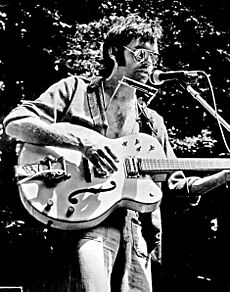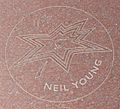Neil Young facts for kids
Quick facts for kids
Neil Young
OC OM
|
|
|---|---|
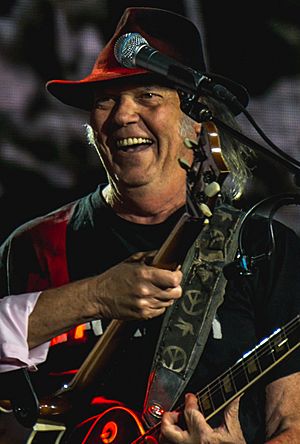
Young in 2016
|
|
| Born |
Neil Percival Young
November 12, 1945 Toronto, Ontario, Canada
|
| Other names | Bernard Shakey Joe Yankee |
| Citizenship |
|
| Occupation |
|
| Years active | 1963–present |
|
Works
|
Full list |
| Spouse(s) |
Susan Acevedo
(m. 1968; div. 1970) |
| Partner(s) | Carrie Snodgress (1970–1975) |
| Children | 3 |
| Parent(s) |
|
| Relatives | Astrid Young (sister) |
| Musical career | |
| Origin | Winnipeg, Manitoba, Canada |
| Genres | |
| Instruments |
|
| Labels |
|
Neil Percival Young (born November 12, 1945) is a famous Canadian and American singer and songwriter. His father was the writer Scott Young. Neil started his music career in the 1960s in Winnipeg, Canada. He later moved to Los Angeles and formed the folk rock group Buffalo Springfield.
As a solo artist, he often played with the band Crazy Horse. He released many popular albums, including Everybody Knows This Is Nowhere (1969), After the Gold Rush (1970), and Harvest (1972). He was also a member of the supergroup Crosby, Stills, Nash & Young.
Young is known for his unique guitar playing, personal lyrics, and high singing voice. He plays many instruments, including the piano and harmonica. His music mixes folk, rock, and country. His distorted electric guitar sound earned him the nickname "Godfather of Grunge" and inspired bands like Pearl Jam.
Young has won many Grammy and Juno Awards. The Rock and Roll Hall of Fame added him twice: once as a solo artist in 1995 and again in 1997 as a member of Buffalo Springfield. In 2023, Rolling Stone magazine named him one of the greatest guitarists of all time.
Contents
Early Life and First Bands
Neil Young was born in Toronto, Canada, on November 12, 1945. His father, Scott, was a journalist and writer, and his mother was Edna. When he was a child, his family moved to the small town of Omemee, Ontario.
In 1951, Young got sick with polio, which left his left side partially weak. His family spent a winter in Florida to help him recover. When he was 12, his parents divorced. Neil and his mother moved to Winnipeg, while his brother Bob stayed in Toronto with their father.
In the 1950s, Young loved listening to rock and roll, country, and R&B music. He was a big fan of Elvis Presley. He started playing music on a plastic ukulele before learning guitar.
Starting a Music Career
In Winnipeg, Young went to high school and formed his first band, the Jades. He later joined a band called the Squires. They had a local hit song called "The Sultan" and played many shows in the area.
After leaving the Squires, Young played in folk clubs where he met another future star, Joni Mitchell. He wrote some of his most famous early songs there, like "Sugar Mountain". In 1966, he joined a band called the Mynah Birds, which was led by singer Rick James. After that band broke up, Young and bass player Bruce Palmer moved to Los Angeles to find more opportunities in music.
Rise to Fame
Buffalo Springfield
In Los Angeles, Young and Palmer met Stephen Stills and Richie Furay. Together with drummer Dewey Martin, they formed the band Buffalo Springfield. Their music was a mix of folk, country, and rock.
The band became successful with their song "For What It's Worth". Buffalo Springfield helped create the genres of folk rock and country rock. However, the band members did not always get along, and the group broke up in 1968. They released a final album, Last Time Around, to complete their contract.
Solo Career and Crazy Horse
After Buffalo Springfield, Young signed a solo record deal. His first album, Neil Young (1969), had mixed reviews. For his next album, he teamed up with a band called the Rockets, which he renamed Crazy Horse.
Their album Everybody Knows This Is Nowhere (1969) was a big success. It included classic songs like "Cinnamon Girl", "Cowgirl in the Sand", and "Down by the River". Young wrote all three songs in a single day while he was sick with a high fever.
Crosby, Stills, Nash & Young
Soon after, Young joined his friend Stephen Stills's band, Crosby, Stills & Nash. The group was renamed Crosby, Stills, Nash & Young (CSNY). The four musicians debuted at a festival in Chicago and played at the famous Woodstock Festival in 1969.
Their first album together, Déjà Vu (1970), was a huge hit. But the band members often argued, especially Young and Stills. After the Kent State massacre in 1970, Young wrote the protest song "Ohio", which CSNY quickly recorded and released.
A Decade of Classic Albums
Harvest and Mainstream Success
In 1970, Young released his third solo album, After the Gold Rush. It became a commercial success and included famous songs like "Southern Man" and the title track. The song "Southern Man" criticized racism in the American South. This led the band Lynyrd Skynyrd to mention Young in their song "Sweet Home Alabama".
In 1971, Young went to Nashville to record new music. He worked with a group of local musicians he called The Stray Gators. The result was his most successful album, Harvest (1972). It included his only No. 1 hit single, "Heart of Gold", and another popular song, "Old Man".
The huge success of Harvest made Young uncomfortable. He later wrote that being "in the middle of the road" was boring, so he decided to head "for the ditch" to make more interesting music.
The "Ditch" Trilogy
Young's next few albums were darker and less commercial. This period is known to fans as the "Ditch Trilogy". The first album was Time Fades Away (1973), a live album of new songs. It was recorded during a difficult tour. A member of his band, Danny Whitten, died suddenly from health problems just before the tour began, which deeply affected Young.
Next came On the Beach (1974), which had a softer sound but still explored serious themes. The final album of the trilogy was Tonight's the Night (1975). It was inspired by the deaths of Whitten and another friend, Bruce Berry. The record company delayed its release for two years because it was so raw and dark. Today, these albums are considered some of his best work.
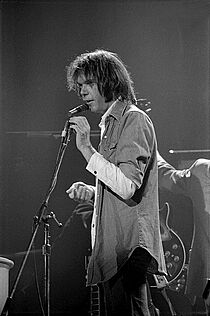
Rust Never Sleeps
In the late 1970s, Young's music became popular with a new generation. In 1978, he toured with Crazy Horse for his Rust Never Sleeps shows. The concerts were split into two parts: a quiet acoustic set and a loud electric set.
The tour led to two albums in 1979: Rust Never Sleeps and the live album Live Rust. The albums featured the famous line, "It's better to burn out than to fade away." This raw, distorted sound was a big influence on the grunge music scene that would emerge in the 1990s.
Experimental Music and a Return to Form
The 1980s
In the 1980s, Young experimented with different music styles. He released Trans (1982), an electronic album that used synthesizers and voice-changing devices called vocoders. He followed it with Everybody's Rockin' (1983), a short album of rockabilly songs.
His record label, Geffen Records, was not happy with these experimental albums. They sued him for making music that was "unrepresentative" of his usual style. He returned to a more classic sound with albums like This Note's For You (1988).
The 1990s: Godfather of Grunge
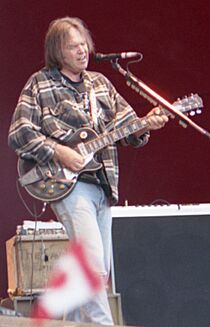
Young's 1989 album Freedom brought him back into the spotlight. It included the hit song "Rockin' in the Free World", which commented on social problems. The album's heavy guitar sound influenced many new bands.
Artists like Nirvana's Kurt Cobain and Pearl Jam's Eddie Vedder called Young a major influence. This earned him the title "Godfather of Grunge." In 1995, he recorded the album Mirror Ball with Pearl Jam.
He also returned to his folk and country roots with the album Harvest Moon (1992). It was a sequel to his famous Harvest album and won the Juno Award for Album of the Year in 1994.
Later Career and Activism
Young has continued to release music and tour regularly. In the 2000s, he released Greendale (2003), a concept album about life in a small town. He also released Living with War (2006), an album protesting the Iraq War.
In March 2005, Young had surgery for a brain aneurysm but recovered quickly. He has continued to work with different musicians, including the band Lukas Nelson & Promise of the Real.
Activism and Charity Work
Young is known for his work as an activist. In 1985, he co-founded Farm Aid with Willie Nelson and John Mellencamp. Farm Aid is a series of concerts that raises money to help family farmers in the United States.
He also helped start the Bridge School, a school for children with severe disabilities. He and his then-wife Pegi hosted annual benefit concerts for the school for 30 years. Young is also a strong supporter of environmental causes and has spoken out against oil pipelines and in favor of sustainable farming.
Personal Life
Young has been married three times and has three children. His sons, Zeke and Ben, both have cerebral palsy, and his daughter, Amber, has epilepsy. His experiences as a father inspired him to help found the Bridge School.
In 2014, Young began dating actress Daryl Hannah, and they married in 2018. In 2020, after living in the United States for many years, Young became a U.S. citizen. He now holds dual citizenship with Canada.
Images for kids
-
The Last Waltz, Young (center on left microphone) performing with Bob Dylan and The Band, among others in 1976
-
Young playing in Barcelona, Spain, 1984
-
Young on stage in Barcelona
-
Crosby, Stills, Nash & Young perform in 2006. (From L to R: Nash, Stills, Young, and Crosby)
-
Young performing in Oslo, Norway, in 2009
-
Neil Young performing "Heart of Gold" in support of Fairy Creek Old Growth activists, at the legislature, Victoria, BC, Feb 24, 2023
-
Young's star on Canada's Walk of Fame
See also
 In Spanish: Neil Young para niños
In Spanish: Neil Young para niños


